What it is, how to make it, and how to eat it: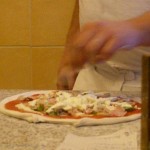
Foreword
I have a bad habit: when I learn something about The Right Way To Do Things I immediately turn into a snob. Whether it's grammar, computer tricks, or cooking, once I know the best and proper way to do something I get pretty hoity-toity about it. That is not to say I am unwilling to learn an even better way, but if I discover something secret or authentic, I want you to know about it.
When I visited Naples in 2007 – the visit that made me decide to move there immediately – I experienced pizza The Way God And The Universe Intended. I can't ever eat pizza now without comparing it to the best in the world. And now, having married into a Neapolitan family, I hold a degree in the field of faux expertise di pizza.
Wood-fired Pizza Margherita in Napoli. It doesn't get any better than this.
See, back in the US, I never really liked pizza that much. It is probably important to point out that I grew up on the West Coast, so I really only had Dominos and Pizza Hut. I couldn't figure out why so many people went on and on about it, as it always seemed to have too much cheese and not nearly enough sauce. When I visited Naples for the first time I finally got it.
Before we go any further, let's set the tone with some music, shall we? Play this while you read the rest of the post. Or maybe take a happy dance break and get the blood flowing before you continue reading. Really, it'll totally brighten your day!
Rosemary Clooney – Mambo Italiano on YouTube: https://youtu.be/44CQbWDDd64
. . . ready? Ok, good.
Terminology
Next, how much do you know about Pizza Margherita? Wait, no – let me back up. There are a few things you need to know about Italian terminology. I want to be sure we're speaking the same language here. Er, so to speak. Um. Well, let me just get to the list…
Pasta (dough) – the word "pasta" can be used to mean anything made with flour; pizza dough is more properly impasto, but may also be referred to as pasta per la pizza.
Pasta (boiled or baked) – Everything long and thin is called "pasta lunga". Everything else is "pasta corta" or maccheroni (plural) with some exceptions:
1) oddly shaped, modern-day pasta (e.g., farfalle)
2) Stuffed pasta and pasta made with unusual ingredients (gnocchi, ravioli, tortellini)
3) pastina – tiny shapes (like stars, for example), often used in soups
4) pasta all'uovo – usually big, flat noodles for things like lasagna; named as such because they contain eggs in addition to flour and water
Pizza – two main types: regular round, wood-fired "pizza" (includes Margherita, marinara, capricciosa, etc.) and pizza fritta (fried). Pizza fritta is like a small pizza folded in half with the edges pinched together, and the whole thing is deep fried.
Rustico – very similar to regular pizza, but has a layer of dough over the top.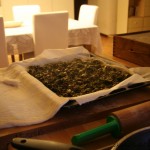
Peperoni (yes, spelled like that) – Peppers, not meat! What North Americans (and even Irish folks) consider "pepperoni pizza" is actually pizza con salame, though really that doesn't exist as such in Italy. If you really want salame with your pizza, you order a calzone instead.
Mozzarella – There are two main types: plain "mozzarella" made from cows' milk (includes fior di latte) and mozzarella di bufala, made from a combination of cow and water buffalo milk. Once upon a time it was made from 100% buffalo milk, but nowadays it's often a blend, if not always marked as such on the label. (There's been stuff in the news in recent years about widespread fraud.)
You should also know mozzarella is in its own food group – really! It's not considered cheese by most Italians.
. . . head melted yet?
Definition
Contrary to what some pizza joints would have you believe, it is NOT merely a fancifully named cheese pizza. As stated in my review of the best pizzeria in Naples, "I'm afraid I must restrain myself from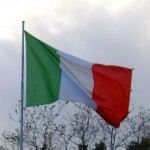 ranting here, as there seems to be a tremendous misunderstanding elsewhere in the world when it comes to what comprises a Margherita. Suffice it to say that it is named after a queen and it must have the three colors of the Italian flag. Red is represented by the tomato sauce, white by the mozzarella, and green by fresh basil leaves (exception can be made in winter when the fresh herb is out of season, in which case dried may be used). Without the basil, it is simply a glorified cheese pizza." (The queen in question is Margherita of Savoy.)
ranting here, as there seems to be a tremendous misunderstanding elsewhere in the world when it comes to what comprises a Margherita. Suffice it to say that it is named after a queen and it must have the three colors of the Italian flag. Red is represented by the tomato sauce, white by the mozzarella, and green by fresh basil leaves (exception can be made in winter when the fresh herb is out of season, in which case dried may be used). Without the basil, it is simply a glorified cheese pizza." (The queen in question is Margherita of Savoy.)
And really, clarification is the main reason for this post. As much as Dario and I absolutely LOVE Ireland, we were both surprised (and a little appalled) by what passed as pizza there, especially the things that got labeled "Margherita". I mean, I had grown up with some pretty horrible pizza in the US, but at least the commercial chains there don't pretend that what they are serving is in anyway close to a Margherita. Hawaiian pizza? Hell yes! Meat lover's pizza? You betcha! 3 Cheese Pizza? Enough to choke a cow! …But Margherita? No way.
In Cucina Napoletana, Arturo Iengo states:
"Neapolitans are so proud of the pizza – and certain devotees so determined to maintain its integrity – that there is even an organization dedicated to ensuring that it is made to the correct standards using traditional methods: the Associazione Vera Pizza Napoletana. Rules for an authentic pizza are: the dough must be made of flour, natural or brewer's yeast, salt, and water only; the dough must be kneaded by hand (or only by devices approved by the association); the pizza must be cooked directly on the oven floor; and it must be baked in a traditional bell-shaped wood-fired oven."
That's for all types of Pizza Napoletana (marinara, etc.), not just Margherita. But still, you get an idea of how serious this pizza thing is, right? So let's take a quick peek at the masters of Antica Pizzeria Sorbillo and move on to the business of learning how to make it ourselves.
Can't see the video? Watch it here: https://youtu.be/ljnHnqfEGjk
Recipes
The two basic parts of pizza that you need a recipe for are the impasto (dough) and the salsa di pomodori (tomato sauce). The only other two parts, as you know, are the mozzarella and fresh basil. The sauce is really quite simple, so we'll start with that. The amounts given are enough for 4 large pizzas.
Sauce
According to Dario, at a pizzeria, they start with peeled, chopped piennolo ("pendulum" in Neapolitan) tomatoes (blanch first for easy peeling). At home, we often use canned tomatoes because they are easier to store. If we are planning for pizza, however, fresh is great!
- 14 oz. / 400 g / 1 can peeled, chopped piennolo tomatoes (plum tomatoes will work, too)
- 2-3 thinly sliced garlic cloves (optional; more common in marinara)
- pinch of salt (optional)
Gently heat ingredients in a sauce pan for just a few minutes, remove from heat and set aside. That's it! Many pizzerias skip the cooking part altogether and put the chopped tomatoes directly on the dough just before cooking.
Some recipes also call for pachino tomatoes, though Dario says it's not something you usually see on a Margherita. They are small varieties like cherry and grape tomatoes and are totally optional. If used, they are simply cut in half and applied in place of the tomato sauce before the mozzarella is added. (I would like to add that the fact I didn't think of Al Pacino until a few hours after I typed that is indication of how much time I've spent in Italy. *shakes head sadly* Pretty soon I'm going to forget what a hamburger, coke, and fries tastes like.)
Dough
- 1 oz. / 28 g fresh yeast (check this link for dry vs. fresh and US vs. European vs. Australian standards)
- 2 cups / 0.5 litre warm water (temperature is important – don't make it too hot!)
- 2-1/4 lb. / 1 kg tipo 0 (or all-purpose) flour
- 1-2 pinches of salt
- 1-2 tbsp olive oil (optional)
Method 1 (recipe book): Dissolve the yeast in a small amount of the water. Add some of the flour and mix well. Shape it into a small ball, leave to rise for 30 min. Make a well in the center of the flour and add the yeast mixture, remaining warm water, and salt. Knead vigorously on a floured work surface for about 10 minutes, adding water a little at a time until the dough is smooth but not sticky. Let it rise for at least an hour.
Method 2 (the way we do it): Split the water and flour in half. In a bowl, dissolve the yeast in a small amount of water; keep half of the water for mixing into this bowl. In a different bowl put salt in the other half of the water. Slowly add flour to each half, mixing thoroughly. Mix the two batches together, adding a small amount of extra water (and the oil) if needed. Dough should be smooth, but not sticky. Let it rise for a couple of hours; overnight is even better.
If it's a lovely day, you can take all the ingredients out to the garden and mix everything there.
Action shot with flying flour! POW! *BAM!* ZOWIE!
Pause: time to preheat the oven: 180°C / 350°F
The longer you let the dough rise, the better. It gets easier to work with and the crust turns out more flavorful. When you are ready to work with it, put 1/4 of the mixture onto a floured surface. If you want to do it the Right Way, you do most of the action by hand, rarely setting the dough down, patting it into a round shape and spinning it madly in the air while dancing and singing O Sole Mio (dancing and singing optional).
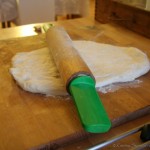 If you want to go the more efficient, if less showy, route you can do it all on the table by hand or even using a rolling pin. Mamma and Papà do it this way, though Dario turns his spoilt nose up at the prospect. The idea is just to get it as thin and even as you can.
If you want to go the more efficient, if less showy, route you can do it all on the table by hand or even using a rolling pin. Mamma and Papà do it this way, though Dario turns his spoilt nose up at the prospect. The idea is just to get it as thin and even as you can.
Here's where I would like to clarify the consideration of oil in the recipe. The Associazione Vera Pizza Napoletana forbids the use of oil in the dough recipe. Dario's mother generally uses it only for pizza fritta. I have always struggled with the flattening part, as the dough seems terribly gummy and elastic to me. Perhaps more water would do the trick, but then the dough would be sticky. One of my American-written "Neapolitan" cookbooks has oil as part of the recipe. We tried it last time we made pizza and it was great! The dough was softer and easier to work with, and the crust had more flavor. So – officially it's a no-no, but practically it's faboo (that's good)!
With regard to pans, square is ok – we do it all the time. You'll probably want some baking paper (similar to wax paper in the US) to make pizza extraction and re-use of the pan easier. Once you've got the dough laid out in a pan, spread a quarter of the sauce evenly over the surface, leaving space only at the edges. There should not be too much liquid, as that will interfere with the cooking time. Add the halved pachino (cherry) tomatoes if you've got them, lay 6-8 thin slices of fresh mozzarella on top, drop on a few leaves of fresh basil, and drizzle a tablespoon of olive oil over everything. Now you're ready to cook that thing up!
In a Neapolitan pizzeria, this is where you'd stick it into the bell-shaped wood-fired oven for about 3 minutes. At home, and depending on whether you've got a convection oven, gas or electric, etc. it can take up to 15 minutes. The thickness of the dough, the amount of sauce, how much liquid the tomatoes had in them, etc. – all of these can affect the cooking time. Keep an eye on it the first couple of times you use this recipe. You can tell it's done when the mozzarella is melted, the sauce is bubbling gently, the crust has browned, and it smells so good that you're drooling on your shirt.
Quiz time: what essential ingredient is missing from this pizza? Why is it not a Margherita?
Delicious, even without being a Margherita. *droool…*
I hope you read the entire post before starting on your pizza baking odyssey. Otherwise, you're going to pull your pizza out of the oven and not know what to do with it, right? Let me set your mind at ease.
How To Eat It
Perhaps because we were hosting so many travel-minded folks in our homes (yay, CouchSurfing!) who had come to Naples specifically to try the world's best pizza, Dario and I were frequently asked about HOW to eat pizza. The answer is…
It depends.
When pizza is taken home from a pizzeria, it is often cut into quarters by the establishment for easy folding and consumption by hand. This is not always the case, however. In fact, in the course of writing this post (it's taken ages – national and family pride is at stake, so I had to get it right!), my brother-in-law surprised the family and bought us all pizza the other night. Naturally I ordered a Margherita.
When I opened the box I discovered it had not been pre-cut. This possibility had been foreseen and each of us had: 1) our own pizza in a box, 2) two glasses each – one for wine, one for water, and 3) a knife and fork. This (sans the box) is also how it's served in restaurants and pizzerias. The utensils, however, are not necessarily an indication that the dish must be eaten with such. I'm going to quote myself again:
"I have heard of tourists suddenly feeling self-conscious after starting to eat their pizza by hand and realizing that most of the other restaurant patrons were using cutlery. I don't know if they were in a less casual environment when this happened, if the sudden realization that "one of these things is not like the other" worked on its own, or if Italian diners were actually giving them the stink eye. If the latter (which I doubt, as Italians have a remarkable ability to mind their own business in a city with such a high population density), it's possible that they were simply holding the slice wrong. That is, a slice thinner than 1/4 of the pizza and possibly held flat, rather than folded vertically."
Caveat: every Italian you ask will probably have a different answer to this question. With Dario's family, we always eat pizza with our hands. The only exception is when it comes straight from the oven and is too hot to touch. Everyone begins by cutting it into quarters with fork and knife (as we did the other night) then having a few bites via utensil. As soon as it's safe, we all pick it up. As Mamma says, "Food tastes better when eaten by hand!" True, that!
When Sherry Ott asked us this same question, we did better than describe the answer – we took her to Naples and showed her. She's gone and made us YouTube famous! I'm also grateful to her for giving me another job description to fill in on my CV (aka, resumé): pizza folder. Thanks, Sherry!
Sherry is offering you pizza.
Now that you're an expert,
are you going to invite me over for pizza?
I'll bring the wine.
Addendum: Barbara of Naples (Napoli) Guide, and author of Espresso Break: Tours and Nooks of Naples, Italy and Beyond, reminded me that there are two other important spots in Naples you should know. One is the birthplace of pizza – yes, the actual restaurant where it was invented – and the other is the birthplace of Pizza Margherita. So the 3 places you should visit if you want to be a true pizza connoisseur are:
1) Antica Pizza Sorbillo – best pizza in Naples
2) Pizzeria Brandi – where Pizza Margherita was invented
3) L'antica Pizzeria Port'Alba – birthplace of pizza
Go forth and eat pizza!
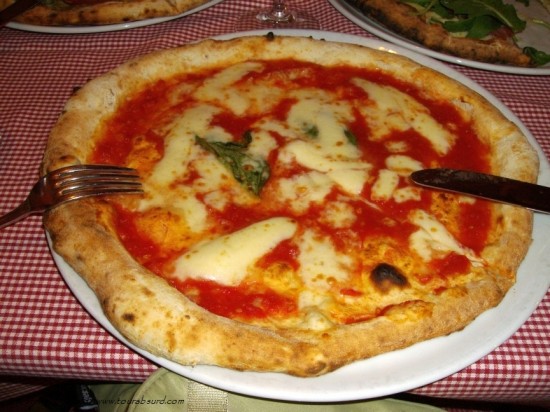
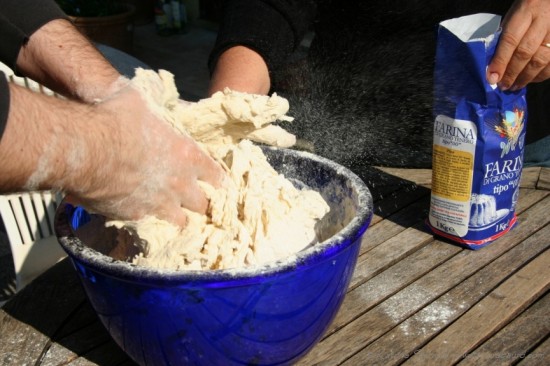
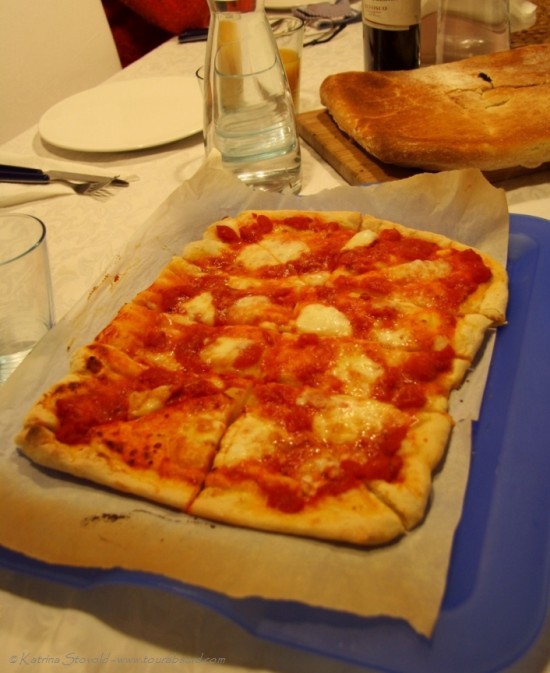
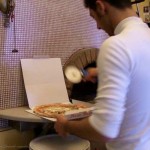
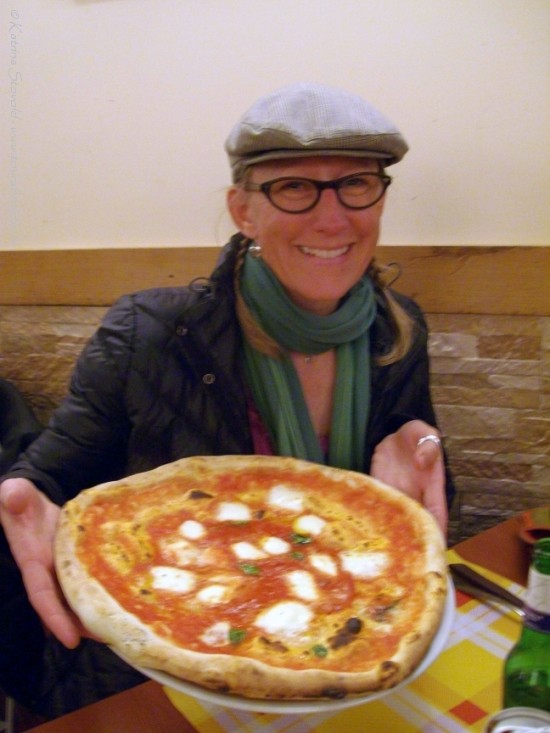
YUM, yum, yum. I need to go to Naples!!
Indeed! Every pizza fantasy you’ve had will be fulfilled! ;)
I’ve seriously got the urge to have a tasty pizza now, it always makes me laugh seeing people eat their pizza with a knife and fork, I meaning come on, isn’t half the fun of eating one to use your hands ;)
Hey, Karen!
After reading this, more than one friend has said they want to go to Naples with us to taste the pizza. Unfortunately, most of these friends are on different continents. HOWEVER, one is here in Italy so we may hop down again in the next few weeks.
Since the whole utensil vs. hands thing has come up so many times, I am going to pay especially close attention while we are there. I hope to go to more than one pizzeria for control purposes, too. Mamma insists that Neapolitans eat pizza with their hands, even if Romans – who really don’t know from good pizza anyway – get stuck in utensil land. (Maybe they are so ashamed of their pizza, they don’t want to touch it? ;)
I am totally with you on the fun part. But then, maybe I’m just a barbarian. Happy to be so if being refined means not having fun. ;)
Oh, I totally agree with you! To give you an example, let me tell you that I’ve given up going to Italian restaurants here in the NL. I just can’t! I’m always horrified when I see dishes that are nothing like the real thing or when they have waiters that have no clue what they’re serving. So we’ve decided that the only Italian food we’re eating is the food that we can make at home, at least until we go back to Argentina :) or better still, to ITaly some day!
Napoli is definitely on my list, to try la vera pizza napolitana!!! :)
Cheers!
Don’t give up hope, Aledys! It may not be possible to find exact ingredients, but southern Italians do have a tendency to migrate and take their pizza-making secrets with them. Perhaps you can find a Neapolitan-run pizzeria in the NL. But if not, yeah, make it at home. ;)
The music really got me in the mood to make pizza, haha! :D It really looks delicious.
Haha, that’s great! I’m never sure if people will appreciate the silliness in the same way I do. I was flattered when someone on Reddit recently said, “Upvote for mambo italiano!” Yay for music!
And it really is so much easier than you think before you do it the first time. I remember that Dario once invited a friend over to our place in Ireland and he promised homemade pizza, only we were out of yeast the night before. He had to go to work the next day and asked me to make the dough. I nearly panicked – *me* representing All That Is Naples? He calmed me down and walked me through the process… Really simple, after all. ;)
So hungry now for a good pizza margherita! In my experience in Italy, I haven’t seen Italians eating pizza with their hands. Perhaps it’s a geographic thing or just pizzeria to pizzeria. I might have to return to have a pie in Naples. It’s been too long.
You know, I asked Mamma about that again the other night. She insisted that Neapolitans nearly always eat pizza with their hands. Romans, she said, most often use knife and fork – but then, who wants to eat Roman pizza, anyway? ;)
I lived in Rome for 4 years where the pizza, particularly ai fungi (mushroom) is absolutely fabulous. I would never eat pizza in Rome with my hands and I have never seen an Italian do it. Customs, manners, food and terminology differ greatly in the different regions in Italy, so one must be ready to adapt to different ways. It’s like pasta. In my opinion, the Romans make the best pasta using tipo 0 flour. The Tuscans and in norther Italy they use a darker durum wheat flour which makes a very hard type of pasta. I much prefer the Roman style which is more delicate.
Hey, Linda! The only places we’ll eat pizza in Rome anymore are those run by Neapolitans. Have had too many bad pizzas from Roman pizzerias. If you have any names of good places, however, would love to hear it!
As far as eating pizza by hand goes, like I said, every Italian you ask will probably give you a different answer – it’s ok in this situation, but not this one, etc. Among the Italians I know, love, and live with, we eat it by hand. And to me, it definitely tastes better that way! ;)
I LOVE this post! Except that it has made me CRAVE pizza!!!! I’m going to bookmark it and one day, when I have an oven again, I shall try it!
Oh, my goodness! Life without an oven? Horrors! …well, in summer in Tenerife, I imagine you could take a little foil and set it on the sidewalk. ;)
I am thinking more and more about trying to set up some kind of gathering for blogger friends in Naples next year. Must go on a pizza-sampling tour!
Ha! This post is so wonderful! I would whole-heartedly agree: there is only ONE way to make pizza… and that’s the Neapolitan way. :)
Thanks so much, Barbara! Your site has reminded me that I should include a little info on the places where pizza and the Margherita were invented. I’ve been to both, but only had pizza at one. I will have to remedy this situation!
My mouth is watering….
I should have included a free napkin with the post. ;)
The more I travel around Italy the more I appreciate the subtle differences in all the pizzas. Here was silly ol’ me just thinking they were all bread, tomato sauce and some toppings! :)
Oh, the horrors! But that’s ok, Michael, I was once like you, “lost in the sauce”, as they used to say in the Marine Corps. I don’t think they meant it as pizza-related word play, but I’ll take what I can get. …then again, I’m sure there are tons of Asian foods I’ve never heard of that you have mastered in your travels. Some day we must powwow in a well-stocked kitchen!
Peperoni is not meat?? I love learning about Neopolitan pizza, especially since I am a big fan of pizza of all kinds — anywhere. Delicious pics and recipe. Mambo Italiano is a nice touch, too. ;)
I know, I know – mind blown, right? I’m just doing my bit for international relations and world peace through pizza. ;)
Awesome, you tell people how to make it and I tell them how to eat it. A match made in heaven.
And yes – our Naples pizza experience ruined me for life now…it will never be that good again. Unless of course I use your recipe to make my own!
We’ll have to plan a Neapolitan reunion one of these days. Thanks so much for including us in your video, Sherry. Totally cracked me up!